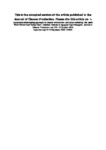A sustainable shipbreaking approach for cleaner environment and better wellbeing
| dc.contributor.author | Rizvi, MJ | |
| dc.contributor.author | Islam, MR | |
| dc.contributor.author | Adekola, O | |
| dc.contributor.author | Margaret, ON | |
| dc.date.accessioned | 2020-07-10T18:30:54Z | |
| dc.date.available | 2020-07-10T18:30:54Z | |
| dc.date.issued | 2020-10-10 | |
| dc.identifier.issn | 0959-6526 | |
| dc.identifier.other | 122522 | |
| dc.identifier.uri | http://hdl.handle.net/10026.1/15999 | |
| dc.description | 12 month embargo. | |
| dc.description.abstract |
Shipbreaking has great economic benefits but generates substantial hazardous materials as wastes to the surrounding environment of shipbreaking yards. Currently, a number of methods are exercised all over the world for breaking ships. However, ‘beaching method’ is of most concerns due to its nature of activities. A computer simulation has been carried out and the results reveal that the toxic wastes which, without proper management and treatment, accumulate on the yard ground and gradually diffuses into soil. Thus, leach to sea-water, contaminate and degrade water quality, create a declining trend of biotic structure and eventually affect the ecological systems resulting in sudden or gradual disappearance of mangroves and vegetation. Computer simulation results also confirm that if shipbreaking activities are performed on a bed that is constructed using pebbles of various sizes in such a way that the pebble size gradually increases and the bed permeability gradually decreases across the depth starting from the top surface of the bed, the concentration of hazardous materials could be restricted and catastrophic environmental damages could be avoided. The proposed shipbreaking approach is thought to be sustainable as it uses naturally found construction materials which could be reused for other purposes and offers cleaner, environmentally sound production process of raw materials without incurring significant implementation costs. | |
| dc.format.extent | 122522-122522 | |
| dc.language | en | |
| dc.language.iso | en | |
| dc.publisher | Elsevier BV | |
| dc.rights | Attribution-NonCommercial-NoDerivatives 4.0 International | |
| dc.rights | Attribution-NonCommercial-NoDerivatives 4.0 International | |
| dc.rights | Attribution-NonCommercial-NoDerivatives 4.0 International | |
| dc.rights | Attribution-NonCommercial-NoDerivatives 4.0 International | |
| dc.rights | Attribution-NonCommercial-NoDerivatives 4.0 International | |
| dc.rights.uri | http://creativecommons.org/licenses/by-nc-nd/4.0/ | |
| dc.rights.uri | http://creativecommons.org/licenses/by-nc-nd/4.0/ | |
| dc.rights.uri | http://creativecommons.org/licenses/by-nc-nd/4.0/ | |
| dc.rights.uri | http://creativecommons.org/licenses/by-nc-nd/4.0/ | |
| dc.rights.uri | http://creativecommons.org/licenses/by-nc-nd/4.0/ | |
| dc.title | A sustainable shipbreaking approach for cleaner environment and better wellbeing | |
| dc.type | journal-article | |
| dc.type | Journal Article | |
| plymouth.volume | 270 | |
| plymouth.publication-status | Published | |
| plymouth.journal | Journal of Cleaner Production | |
| dc.identifier.doi | 10.1016/j.jclepro.2020.122522 | |
| plymouth.organisational-group | /Plymouth | |
| plymouth.organisational-group | /Plymouth/Faculty of Science and Engineering | |
| plymouth.organisational-group | /Plymouth/Faculty of Science and Engineering/School of Engineering, Computing and Mathematics | |
| plymouth.organisational-group | /Plymouth/REF 2021 Researchers by UoA | |
| plymouth.organisational-group | /Plymouth/REF 2021 Researchers by UoA/UoA12 Engineering | |
| plymouth.organisational-group | /Plymouth/Users by role | |
| plymouth.organisational-group | /Plymouth/Users by role/Academics | |
| dcterms.dateAccepted | 2020-06-03 | |
| dc.rights.embargodate | 2021-6-15 | |
| dc.rights.embargoperiod | Not known | |
| rioxxterms.funder | Royal Academy of Engineering | |
| rioxxterms.identifier.project | Sustainable ship breaking process for cleaner environment and better wellbeing | |
| rioxxterms.versionofrecord | 10.1016/j.jclepro.2020.122522 | |
| rioxxterms.licenseref.uri | http://creativecommons.org/licenses/by-nc-nd/4.0/ | |
| rioxxterms.licenseref.startdate | 2020-10-10 | |
| rioxxterms.type | Journal Article/Review | |
| plymouth.funder | Sustainable ship breaking process for cleaner environment and better wellbeing::Royal Academy of Engineering |



